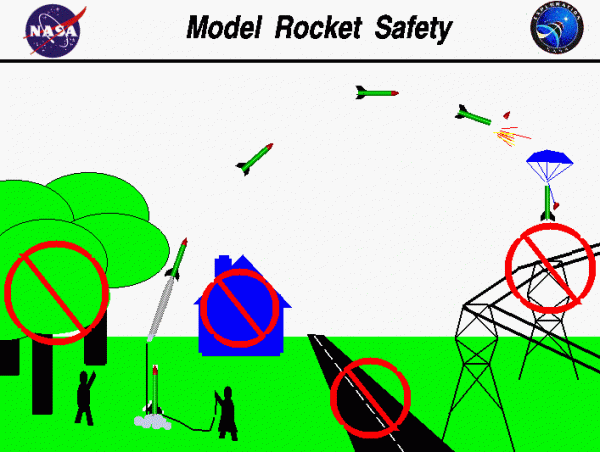Model Rocket Safety

Flying Model Rockets
Flying model rockets is a relatively inexpensive, fun-filled way for students to learn the basics of forces and the response of a vehicle to external forces. Students can also learn some of the basics of full-scale rocket operation and performance by flying model rockets. Model rocketry is fun, but it can also be dangerous.
Taking Precautions
At NASA, we take safety very seriously in everything that we do. Safety is the first mission in flying, whether it is flying the Space Shuttle, an experimental aircraft, or a model rocket. You must always be aware of the people and things around you which can be harmed by your rocket, or which can harm you or your rocket. Let’s review some of the special safety rules that apply to model rockets.
Pre-Packaged Solid Model Rocket Engines
Pre-packaged engines are relatively inexpensive and have been designed with safety in mind for your model rockets. Check the engines before installing them in the rocket to make sure that the casing and nozzle are sound and have no defects or cracks. Never try to re-use or re-pack a spent solid rocket engine. Don’t brew your own fuel. This is extremely dangerous, and students are killed and maimed every year attempting to mix their own fuels. Don’t attempt to modify the nozzle or the casing of the solid rocket engine.
Usage of Non-Metal Parts
For the rocket itself, use only cardboard tubes and balsa or plastic fins and nose cones. Don’t use any metal parts. Before flight, check for loose fins, launch lugs, and shock cords. Check the condition of your recovery system. Check the stability of your rocket with the engine installed. Be sure that your nose cone does not fit too tightly in the body tube. A nose cone that is too tight can cause the engine to be expelled by the ejection charge with subsequent loss of the rocket.
Special Dangers During Launch
Only use the electrical launching devices that come with your launch rail and launch pad. Don’t try to use fuses and matches. Make sure that the safety key is removed when connecting the clips to the wires of the igniters. You don’t want the rocket going off in your hands. Make sure that no one is “playing with” the launcher while you are at the pad. Make sure that the pad is securely anchored so that it doesn’t tilt or fall over with a large rocket. Be careful near the pad. Place a cup over the top of the launch rail when you are at the pad so that you don’t accidentally get poked in the eye. Clear the pad area before launching. Call out a countdown so that others in the area are aware that a rocket is being launched. Don’t fly in high winds or in threatening weather. Weather cocking makes it very hard to predict where your rocket will come down in high winds.
Safety While Launching
Fly your rocket in an open field where there are no obstacles. Never fly near trees. If your rocket ends up in a tree, you’re going to need a new rocket. Never fly near a highway. You can be hurt chasing your rocket across the highway and people driving by are often distracted by model rockets. Never fly near houses. Your rocket can do damage to the windows, sidings and roof of a house. If your rocket ends up on the roof, you’re going to need a new rocket. And never, ever fly near high tension wires. That’s a sure way to lose a rocket.
